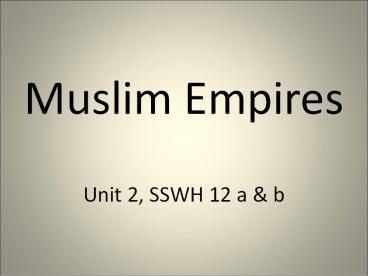Muslim Empires Unit 2, SSWH 12 a PowerPoint PPT Presentation
Title: Muslim Empires Unit 2, SSWH 12 a
1
Muslim EmpiresUnit 2, SSWH 12 a b
2
What were the origins and contributions of the
Ottomans, Safavid, and Mughal empires?
3
a. Describe the geographical extent of the
Ottoman Empire during the rule of Suleyman the
Magnificent, the Safavid Empire during the reign
of Shah Abbas I, and the Mughal Empire during the
reigns of Babur and Akbar. b. Explain the ways
in which these Muslim empires influenced
religion, law, and the arts in their parts of the
world.
4
Ottoman Empire(Modern Turkey)
- Suleyman-Known as the Magnificent for his court
cultural achievements, created a law code - Conquers parts of Europe, Asia, Africa
- Simplified taxation govt., everyone wanted in
the army education - Toleration Christians Jews (1 god Holy Book)
- Cultures (religion, art, architecture, language,
trade) spread
5
Safavid Empire(Ancient Persia/Modern Iran)
- Shah Abbas I, Golden Age (time of prosperity)
- Changed the army (based on loyalty not just a
job) - Punished corruption within the govt, also brought
foreigners to work in the govt. - Religious toleration, which increased trade, art,
culture
6
Mughal Empire(Modern India)
- Babur brilliant general, formed Mughal Empire
- Akbar means Greatest One a Liberal Ruler
(grandson of Babur) - Had an extensive army used it, religious
freedom - Abolished tax on Hindu pilgrims non-Muslims
- Govt. run by different foreign officials
- Developed a style of architecture
- Both Safavid and Ottoman declined (poor
leadership)
7
Muslim Influence
- Religion
- Tolerant, most empires allowed practicing of
their own religion - Few had to pay taxed because of religious beliefs
- Law
- Suleyman created a law code to handle both
criminal civil actions
8
Continued
- Art
- Calligraphy beautiful handwriting
- Architecture was the greatest way to show
blending of cultures - Each empire was tolerant which encourage
foreigners to travel bring new ideas of culture
with them
9
Kinfolk
- What do the Ottomans, Safavid, and Mughal empires
have in common? - Jot your Answer 1 Minute Prepare to Share
PowerShow.com is a leading presentation sharing website. It has millions of presentations already uploaded and available with 1,000s more being uploaded by its users every day. Whatever your area of interest, here you’ll be able to find and view presentations you’ll love and possibly download. And, best of all, it is completely free and easy to use.
You might even have a presentation you’d like to share with others. If so, just upload it to PowerShow.com. We’ll convert it to an HTML5 slideshow that includes all the media types you’ve already added: audio, video, music, pictures, animations and transition effects. Then you can share it with your target audience as well as PowerShow.com’s millions of monthly visitors. And, again, it’s all free.
About the Developers
PowerShow.com is brought to you by CrystalGraphics, the award-winning developer and market-leading publisher of rich-media enhancement products for presentations. Our product offerings include millions of PowerPoint templates, diagrams, animated 3D characters and more.

